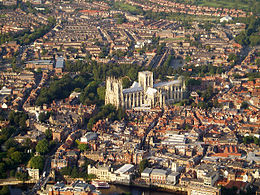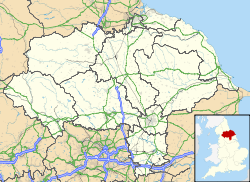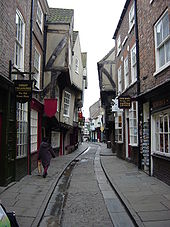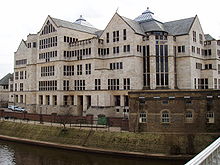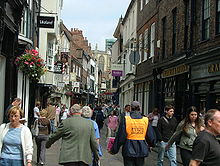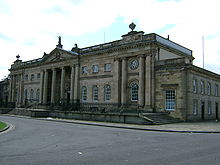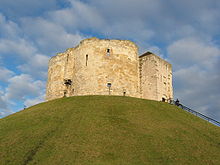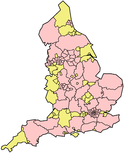- York
-
For other uses, see York (disambiguation).
York — Unitary Authority and City — An aerial view of York, with York Minster in the centre 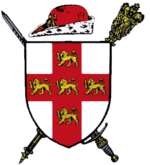
Arms of City of York CouncilNickname(s): "Capital of the North",[1] "Chocolate City"[2] Motto: 'Let the Banner of York Fly High' York shown within North Yorkshire and England Coordinates: 53°57′30″N 1°4′49″W / 53.95833°N 1.08028°WCoordinates: 53°57′30″N 1°4′49″W / 53.95833°N 1.08028°W Sovereign state United Kingdom Constituent country England Region Yorkshire and the Humber Ceremonial county North Yorkshire Admin HQ York City Centre Founded as Eboracum c. 71 AD Government - Type Unitary Authority, City - Governing body City of York Council - Leadership: Leader and Executive - Executive: Labour - MPs: Hugh Bayley (L)
Julian Sturdy (C)Area - Total 105 sq mi (271.94 km2) Population (2010 est.) - Total 202,400 (Ranked 80th) - Density 1,779.3/sq mi (687/km2) - Ethnicity
(2005 Estimates)[3]95.6% Any White
3.0% Any Asian
0.9% Mixed
0.5% Any BlackTime zone Greenwich Mean Time (UTC+0) - Summer (DST) British Summer Time (UTC+1) Postcode YO Area code(s) 01904 ISO 3166-2 GB-YOR ONS code 00FF OS grid reference SE603517 NUTS 3 UKE21 Website www.york.gov.uk York (local
 i/ˈjɔːk/) is a walled city, situated at the confluence of the Rivers Ouse and Foss in North Yorkshire, England. The city has a rich heritage and has provided the backdrop to major political events throughout much of its two millennia of existence. The city offers a wealth of historic attractions, of which York Minster is the most prominent, and a variety of cultural and sporting activities.
i/ˈjɔːk/) is a walled city, situated at the confluence of the Rivers Ouse and Foss in North Yorkshire, England. The city has a rich heritage and has provided the backdrop to major political events throughout much of its two millennia of existence. The city offers a wealth of historic attractions, of which York Minster is the most prominent, and a variety of cultural and sporting activities.The city was founded by the Romans in 71 AD, under the name of Eboracum. It became in turn the capital of the Roman province of Britannia Inferior, and of the kingdoms of Northumbria and Jorvik. In the Middle Ages, York grew as a major wool trading centre and became the capital of the northern ecclesiastical province of the Church of England, a role it has retained.[4]
In the 19th century York became a hub of the railway network and a manufacturing centre. In recent decades, the economy of York has moved from being dominated by its confectionery and railway-related industries to one that provides services. The University of York and health services have become major employers, whilst tourism has become an important element of the local economy.
From 1996, the term City of York describes a unitary authority area which includes rural areas beyond the old city boundaries. In 2001 the urban area had a population of 137,505,[5] while in 2007 the entire unitary authority had an estimated population of 193,300.[6]
Contents
History
Main article: History of YorkToponymy
The word 'York' comes from the Latin name for the city, variously rendered as Eboracum, Eburacum or Eburaci. The first mention of York by this name is dated to c. 95–104 AD as an address on a wooden stylus tablet from the Roman fortress of Vindolanda in Northumberland.[7]
The toponymy of Eboracum is uncertain because the language of the pre-Roman indigenous population of the area was never recorded. These people are thought to have spoken a Celtic language, related to modern Welsh.[8][9][10] Therefore, it is thought that Eboracum is derived from the Brythonic word Eborakon meaning either "place of the yew trees" (cf. yew = efrog in Welsh, eabhrac in Irish Gaelic and eabhraig in Scottish Gaelic, by which names the city is known in those languages) or perhaps "field of Eboras".
The name 'Eboracum' was turned into 'Eoforwic' by the Anglians in the 7th century. This was probably by conflation of 'ebor' with a Germanic root *eburaz (boar); by the 7th century the Old English for boar had become 'eofor', and Eboracum 'Eoforwic'. The 'wic' simply signified 'place'. When the Danish army conquered the city in 866, the name became rendered as 'Jórvík'.[11]
Jórvík was gradually reduced to York in the centuries following the Norman Conquest, moving from the Middle English Yerk in the 14th century through to Yourke in the 16th century and then Yarke in the 17th century. The form York was first recorded in the 13th century.[4][12] Many present day names of companies and places, such as Ebor taxis and the Ebor race meeting, refer to the Roman name.[13] The Archbishop of York also uses Ebor as his surname in his signature.[14]
Early history
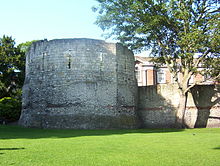 Roman wall and the west corner tower of Eboracum. The top half is medieval.
Roman wall and the west corner tower of Eboracum. The top half is medieval.
Archaeological evidence suggests that Mesolithic people settled in the region of York between 8000 and 7000 BC, although it is not known whether these settlements were permanent or temporary. By the time of the Roman conquest of Britain, the area was occupied by a tribe known to the Romans as the Brigantes. The Brigantian tribal area initially became a Roman client state, but, later its leaders became more hostile to Rome. As a result the Roman Ninth Legion was sent north of the Humber into Brigantian territory.[15]
The city itself was founded in 71 AD, when the Ninth Legion conquered the Brigantes and constructed a wooden military fortress on flat ground above the River Ouse close to its confluence with the River Foss. The fortress, which was later rebuilt in stone, covered an area of 50 acres (20 ha) and was inhabited by 6,000 soldiers. The site of the Roman fortress lies under the foundations of York Minster, and excavations in the Minster's undercroft have revealed some of the original walls.[11][16]
The Emperors Hadrian, Septimius Severus and Constantius I all held court in York during their various campaigns. During his stay, the Emperor Severus proclaimed York capital of the province of Britannia Inferior, and it is likely that it was he who granted York the privileges of a colonia or city. Constantius I died in 306 AD during his stay in York, and his son Constantine the Great was proclaimed Emperor by the troops based in the fortress.[16][17]
While the Roman colonia and fortress were located on high ground, by 400 the town itself was victim to periodic flooding from the rivers Ouse and Foss and lay abandoned.[18] York declined in the post-Roman era, and was taken and settled by the Angles in the 5th century.[19]
Reclamation of the flooded parts of the town were initiated in the 7th century under King Edwin of Northumbria, and York became his chief city.[20] The first Minster church was built in York for the baptism of Edwin in 627.[21] Edwin ordered that this small wooden church should be rebuilt in stone, however, he was killed in 633 and the task of completing the stone Minster fell to his successor Oswald.[11][22] In the following century Alcuin of York came to the cathedral school of York. He had a long career as a teacher and scholar, first at the school at York now known as St Peter's School, York, which was founded in 627 AD, and later as Charlemagne's leading advisor on ecclesiastical and educational affairs.[23]
In 866, Northumbria was in the midst of internecine struggles when the Vikings raided and captured York. Under Viking rule the city became a major river port, part of the extensive Viking trading routes throughout northern Europe. The last ruler of an independent Jórvík, Eric Bloodaxe, was driven from the city in the year 954 by King Edred in his successful attempt to complete the unification of England.[24]
Post conquest
In 1068, two years after the Norman Conquest of England, the people of York rebelled. Initially the rebellion was successful, however, upon the arrival of William the Conqueror the rebellion was put down. William at once built two wooden fortresses on mottes, which are still visible, on either side of the river Ouse. York was ravaged by him as part of the harrying of the North.[25]
The first stone Minster church was badly damaged by fire in the uprising and the Normans later decided to build a new Minster on a new site. Around the year 1080 Archbishop Thomas started building a cathedral that in time became the current Minster.[22] In the 12th century York started to prosper. In 1190, York Castle was the site of an infamous massacre of its Jewish inhabitants, in which at least 150 Jews died (although some authorities put the figure as high as 500).[26]
The city, through its location on the River Ouse and its proximity to the Great North Road became a major trading centre. King Henry I granted the city's first charter, confirming trading rights in England and Europe.[22][27] During the course of the later Middle Ages York merchants imported wine from France, cloth, wax, canvas, and oats from the Low Countries, timber and furs from the Baltic and exported grain to Gascony and grain and wool to the Low Countries.[28] York became a major cloth manufacturing and trading centre. Edward I further stimulated the city's economy by using the city as a base for his war in Scotland. The city was the location of significant unrest during the so-called Peasants' Revolt in 1381. The city acquired an inceasing degree of autonomy from central government including the privileges granted by a charter of Richard II in 1396.
Tudor and Stuart times
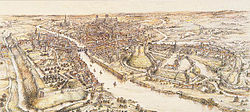 A panorama of 15th century York by E Ridsdale Tate, York Castle is on the right hand side of river, opposite the abandoned motte of Baile Hill
A panorama of 15th century York by E Ridsdale Tate, York Castle is on the right hand side of river, opposite the abandoned motte of Baile Hill
The city underwent a period of economic decline during Tudor times. Under Henry VIII, the Dissolution of the Monasteries saw the end of the York's many monastic houses, including several orders of friars, the hospitals of St Nicholas and of St Leonard, the largest such institution in the north of England. This led to the Pilgrimage of Grace, an uprising of northern Catholics in Yorkshire and Lincolnshire who were opposed to religious reform. Henry VIII restored his authority through the establishmnent of the Council of the North in York in the dissolved St Mary's Abbey. The city very much became a trading and service centre during this period.[29][30]
Guy Fawkes who was born and educated in York was a member of a group of Roman Catholic restorationists that planned the Gunpowder Plot.[31] Its aim was to displace Protestant rule by blowing up the Houses of Parliament while King James I and the entire Protestant and even most of the Catholic aristocracy and nobility were inside.
In 1644, during the Civil War, the Parliamentarians besieged York, and many medieval houses outside the city walls were lost. The barbican at Walmgate Bar was undermined and explosives laid, but, the plot was discovered. On the arrival of Prince Rupert, with an army of 15,000 men, the siege was lifted. The Parliamentarians retreated some 6 miles (10 km) from York with Rupert in pursuit, before turning on his army and soundly defeating it at the Battle of Marston Moor. Of Rupert's 15,000 troops, no fewer than 4,000 were killed and 1,500 captured. The siege was renewed, nevertheless, the city could not hold out for long, and on 15 July the city surrendered to Sir Thomas Fairfax.[29]
Following the restoration of the monarchy in 1660, and the removal of the garrison from York in 1688, the city was dominated by the local gentry and merchants, although the clergy were still important. Competition from the nearby cities of Leeds and Hull, together with silting of the River Ouse, resulted in York losing its pre-eminent position as a trading centre. Nevertheless, the city's role as the social and cultural centre for wealthy northerners was on the rise. York's many elegant townhouses, such as the Lord Mayor's Mansion House and Fairfax House (now owned by York Civic Trust) date from this period, as do the Assembly Rooms, the Theatre Royal, and the Racecourse.[30][32]
Modern history
George Hudson was responsible for bringing the railway to York in 1839. Although Hudson's career as a railway entrepreneur eventually ended in disgrace, by this time, York was a major railway centre.[33] At the turn of the 20th century, the railway accommodated the headquarters and works of the North Eastern Railway, which employed over 5,500 people in York. The railway was also instrumental in the expansion of Rowntree's Cocoa Works. Rowntree's was founded in York in 1862 by Henry Isaac Rowntree, who was joined in 1869 by his brother the philanthropist Joseph Rowntree.[34] Terry's Confectionery Works was also a major employer in the city.[30][35]
With the emergence of tourism as a major industry, the historic core of York became one of the city's major assets, and in 1968 it was designated a conservation area.[36] The existing tourist attractions were supplemented by the establishment of the National Railway Museum in York in 1975.[37] The opening of the University of York in 1963 added to the prosperity of the city.[38] The fast and frequent railway service, which brings York within two hours journey time of London, has resulted in a number of companies opening offices in the city.[35]
York was voted as European Tourism City of the Year by European Cities Marketing in June 2007. York beat 130 other European cities to gain first place, surpassing Gothenburg in Sweden (second) and Valencia in Spain (third).[39]
Governance
Parliamentary constituencies
From 1997 to 2010 the central part of the district was covered by the City of York constituency, while the remainder was split between the constituencies of Ryedale, Selby, and Vale of York.[40] These constituencies were represented by Hugh Bayley, John Greenway, John Grogan, and Anne McIntosh respectively.
Following their review in 2003 of parliamentary representation in North Yorkshire, the Boundary Commission for England recommended the creation of two new seats for the City of York, in time for the general election in 2010. These are York Central, which covers the inner urban area, and is entirely surrounded by the York Outer constituency.[41]
The whole of the city and local authority area lies within the Yorkshire and the Humber constituency of the European Parliament.[42]
Local government
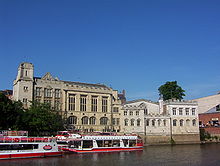 The Guildhall where members of the City of York Council meet.
The Guildhall where members of the City of York Council meet.
York is the traditional county town of Yorkshire, yet it did not form part of any of the three historic ridings, or divisions, of Yorkshire. York is an ancient borough, and was one of the boroughs reformed by the Municipal Corporations Act 1835 to form a municipal borough. It gained the status of a county borough in 1889, under the Local Government Act 1888, and existed so until 1974, when, under the Local Government Act 1972, it became a non-metropolitan district in the county of North Yorkshire.[43][44]
As a result of 1990s UK local government reform, York regained unitary status and saw a substantial alteration in its borders, taking in parts of Selby and Harrogate districts, and about half the population of the Ryedale district.[45] The new boundary was imposed after central government rejected the council's own proposal.
The City of York Council has 47 councillors.[46][47] As a result of the 2011 local elections the Labour Party won 26 seats to give them a majority of 5 seats. The Liberal Democrats have 8 councillors. The Conservative Party has ten councillors and the Greens have two with one Independent.[48]
York Council operates on a Leader and Cabinet style of governance. Councillors are appointed to the cabinet by the full council of 47. Cabinet Members make decisions on their portfolio areas individually.[49][50]
As of May 2011[update], York’s Right Honourable Lord Mayor is Councillor David Horton and his wife, Jane Horton, is the new Lady Mayoress. Councillor Alan Deller is the new Sheriff with his wife, Ann, the Sheriff's Lady.[51] Both appointments are made each May for a period of one year. Although York’s Sheriff office is the oldest in England it is now a purely ceremonial post. The Lord Mayor also carries out civic and ceremonial duties in addition to chairing full meetings of the council.[47]
York Youth Council, consists of several young people who negotiate with the councillors to get better facilities for York's young people.[52][53]
Party Seats City of York Council (2011 election) Labour 26 Conservative 10 Liberal Democrat 8 Green 2 Independent 1 Geography
Main article: Areas of the City of YorkLocation
York lies within the Vale of York, a flat area of fertile arable land bordered by the Pennines, the North York Moors and the Yorkshire Wolds The original city was built at the confluence of the Rivers Ouse and Foss on a terminal moraine left by the last Ice Age.[54]
During Roman times, the land surrounding the rivers Ouse and Foss was very marshy, making the site easier to defend. The city is prone to flooding from the River Ouse, and has an extensive (and mostly effective) network of flood defences. These include walls along the Ouse, and a liftable barrier across the River Foss where it joins the Ouse at the 'Blue Bridge'. In October and November 2000 York experienced the worst flooding in 375 years with over 300 homes being flooded.[55] Much land in and around the city is on flood plains and has always been too flood-prone for development other than agriculture. The ings are flood meadows along the River Ouse, while the strays are open common grassland in various locations around the city.
Climate
York has a temperate climate with four distinct seasons. As with the rest of the Vale of York the city's climate is dryer and warmer than the rest of the Yorkshire and Humberside region. Because of its lowland location York is prone to frosts, fog, and cold winds during winter, spring and very early summer.[56] In summer the average maximum temperature is 22 °C (72 °F) although some days can see highs of up to 28 °C (82 °F) rarely exceeding 30 °C (86 °F). Nights are significantly colder averaging minimum of 15 °C (60 °F), although these can consistently dip below 10 °C (50 °F). The average daytime temperature in winter is 7 °C (45 °F) and 2 °C (36 °F) at night. Snow can fall in winter from December onwards to as late as April, but, quickly melts. The wettest months are November, December and January with an average of 17 days per month with rainfall more than 0.25 millimetres (0.01 in). From May to July York experiences the most sunshine with an average of six hours per day.[57] Extremes recorded at the University of York campus between 1998 and 2010 include a highest temperature of 33 °C (91.4 °F) (Monday 17 July 2006) and a lowest temperature of -12.3 °C (9.9 °F) (Monday 6 December 2010). The most rainfall in one day was 62.4 millimetres (2.5 in).[58]
Climate data for York, England Month Jan Feb Mar Apr May Jun Jul Aug Sep Oct Nov Dec Year Record high °C (°F) 15
(59)17
(63)21
(70)24
(75)29
(84)32
(90)31
(88)33
(91)29
(84)26
(79)19
(66)16
(61)33
(91)Average high °C (°F) 6
(43)7
(45)10
(50)13
(55)16
(61)19
(66)21
(70)21
(70)18
(64)14
(57)10
(50)7
(45)13.5 Daily mean °C (°F) 3.5
(38.3)4
(39)6
(43)8.5
(47.3)11.5
(52.7)14.5
(58.1)16.5
(61.7)16.5
(61.7)14
(57)11.5
(52.7)7
(45)4.5
(40.1)9.75 Average low °C (°F) 1
(34)1
(34)2
(36)4
(39)7
(45)10
(50)12
(54)12
(54)10
(50)7
(45)4
(39)2
(36)6 Record low °C (°F) −14
(7)−10
(14)−13
(9)−3
(27)−1
(30)2
(36)5
(41)4
(39)−1
(30)−4
(25)−8
(18)−11
(12)−14
(7)Precipitation mm (inches) 59
(2.32)46
(1.81)37
(1.46)41
(1.61)50
(1.97)50
(1.97)62
(2.44)68
(2.68)55
(2.17)56
(2.2)65
(2.56)50
(1.97)639
(25.16)Avg. precipitation days 17 15 13 13 13 14 15 14 14 15 17 17 177 Sunshine hours 31 56 93 130 186 180 186 150 120 93 60 31 1,316 Source: BBC Weather[59] Demography
York Compared in 2006/7 2006/7 UK Population Estimates[60] York Yorkshire and the Humber England Total population 193,300 5,177,200 51,092,000 White British 95.0% 91.1% 88.7% Asian 1.9% 5.5% 5.5% Black 0.6% 1.2% 2.8% The York urban area had a population of 137,505[5] comprising 66,142 males and 71,363 females in 2001. Also at the time of the 2001 UK census, the City of York had a total population of 181,094 of whom 93,957 were female and 87,137 were male. Of the 76,920 households in York, 36.0% were married couples living together, 31.3% were one-person households, 8.7% were co-habiting couples and 8.0% were lone parents. The figures for lone parent households were below the national average of 9.5%, and the percentage of married couples was also close to the national average of 36.5%; the proportion of one person households was slightly higher than the national average of 30.1%.[61]
The population density was 6.66 /km2 (17.2 /sq mi). Of those aged 16–74 in York, 24.6% had no academic qualifications, a little lower than 28.9% in all of England. Of York’s residents, 5.1% were born outside the United Kingdom, significantly lower than the national average of 9.2%. White British form 95% of the population, the largest single minority group was recorded as Asian, at 1.9% of the population.
The number of theft-from-a-vehicle offences and theft of a vehicle per 1,000 of the population was 8.8 and 2.7 compared to the English national average of 6.9 and 2.7 respectively.[62] The number of sexual offences was 0.9, in line with the national average.[62] The national average of violence against another person was 16.2 compared to the York average of 16.8.[62] The figures for crime statistics were all recorded during the 2006–07 financial year.
Population change
The table below details the population change since 1801.
Population growth in York since 1801 Year 1801 1811 1821 1831 1841 1851 1861 1871 1881 1891 1901 1911 1921 1931 1941[a] 1951 1961 1971 1981 1991 2001[b] Population 24,080 27,486 30,913 36,340 40,337 49,899 58,632 67,364 76,097 81,802 90,665 100,487 106,278 112,402 123,227 135,093 144,585 154,749 158,170 172,847 181,131 Source: Vision of Britain[63] Religion
Religion in York 2001[64] UK Census 2001 York Yorkshire and
the HumberEngland Christian 74.42% 73.07% 71.74% No religion 16.57% 14.09% 14.59% Muslim 0.58% 3.81% 3.1% Buddhist 0.21% 0.14% 0.28% Hindu 0.19% 0.32% 1.11% Jewish 0.11% 0.23% 0.52% Sikh 0.05% 0.38% 0.67% Other religions 0.30% 0.19% 0.29% Religion not stated 7.57% 7.77% 7.69% Main article: Religion in YorkAt the time of the 2001 UK census the population of York was 181,094 and its ethnic composition was 97.84% white, compared with the English average of 90.92%. York's population has a slightly higher elderly population than the national average.[64] Christianity is the religion with the largest following in York with 74.4% residents reporting themselves as Christian in the 2001 census.
These census figures show no other single religion returned affiliation, as a percentage of population, above the national average for England, but, those responding as "No Religion" was higher than the national average.
There are 32 active Anglican churches in York which is home to the Archbishop of York and the Mother Church, York Minster, and administrative centre of the Diocese of York.[65] York is in the Roman Catholic Diocese of Middlesbrough, has eight Roman Catholic churches and a number of different Catholic religious orders.[66]
Other Christian denominations that are active in York include Religious Society of Friends who have a number of meeting houses in York,[67] Methodists with the York North and York South circuits of The Methodist Church York and Hull District,[68] and Unitarians. There is one mosque in York which also contains a UK Islamic Mission Islamic centre.[69] Various Buddhist traditions are represented in the city and around York.[70]
Economy
Offices of Aviva in York
York's economy is based on the service industry, which in 2000 was responsible for 88.7% of employment in the city.[71] The service industries in York include public sector employment, health, education, finance, information technology (IT) and tourism that accounts for 10.7% of employment. Tourism has become an important element of the local economy, with the city offering a wealth of historic attractions, of which York Minster is the most prominent, as well as a variety of cultural activities. In 2009, York was the 7th most visited city by UK residents and the 13th most visited by overseas visitors.[72][73]
Unemployment in York is low at 4.2% in 2008 compared to the United Kingdom national average of 5.3%.[71] The biggest employer in York is the City of York Council, with over 7,500 employees. Employers with more than 3,000 staff include Aviva (formerly Norwich Union Life), Selby and York Primary Care Trust, Shepherd Building Group (including Portakabin), and University of York. Other major employers include British Telecom, CPP Group (life assistance products), Nestlé, NFU Mutual and a number of railway companies.[74][75]
Today's economic position is very different from the position of the economy as recently as the 1950s, when York's prosperity was based on chocolate manufacturing and the railways. This position continued until the early 1980s when 30% of the workforce were employed by just five employers and 75% of manufacturing jobs were in four companies.[76] Most of the industry around the railway has gone, including the carriage works (known as Asea Brown Boveri or ABB at the time of closure) which at its height in 1880s employed 5,500 people, but, closed in the mid 1990s.[76][77] York is the headquarters of the confectionery manufacturer Nestlé York (formerly Nestlé Rowntrees), and home to the KitKat and eponymous Yorkie bar chocolate brands. Terry's chocolate factory, makers of the Chocolate Orange, was also located in the city; but it closed on 30 September 2005, when production was moved by its owners, Kraft Foods, to Poland. However, the historic factory building can still be seen, situated next to the Knavesmire racecourse.
It was announced on 20 September 2006 that Nestlé would be cutting 645 jobs at the Rowntree's chocolate factory in York.[78] This came after a number of other job losses in the city at Aviva, British Sugar and Terry's chocolate factory.[79] Despite this, the employment situation in York remained fairly buoyant until the effects of the late 2000s recession began to be felt.[80]
Since the closure of York's carriage-works, the site has been developed into the headquarters for CPP Group and two housing schemes, one of which was a self-build project. York's economy has been developing in the areas of science, technology and the creative industries. The city has become a founding National Science City with the creation of a science park near the University of York.[81] Between 1998 and 2008 York gained 80 new technology companies and 2,800 new jobs in the sector.[82]
Regional gross value added figures for York, at 2005 basic prices in pounds sterling, are:[83]
Year Agriculture Industry Services Total 1995 30 579 1,443 2,052 2000 13 782 2,168 2,963 2003 16 779 2,505 3,299 Transport
York's location on the River Ouse and in the centre of the Vale of York means that it has always had a significant position in the nation's transport system.[28] The city grew up as a river port at the confluence of the River Ouse and the River Foss. The Ouse was originally a tidal river, accessible to sea-going ships of the time. Today both of these rivers remain navigable, although the Foss is only navigable for a short distance above the confluence. A lock at Naburn on the Ouse to the south of York means that the river in York is no longer tidal.[84]
Until the end of the 20th century, the Ouse was used by barges to carry freight between York and the port of Hull. The last significant traffic was the supply of newsprint to the local newspaper's Foss-side print works, which continued until 1997. Today navigation is almost exclusively leisure-oriented. YorkBoat provides cruises on the river.[84]

Panorama of the River Ouse looking south from Lendal Bridge Like most cities founded by the Romans, York is well served by long distance trunk roads. The city lies at the intersection of the A19 road from Doncaster to Tyneside, the A59 road from Liverpool to York, the A64 road from Leeds to Scarborough, and the A1079 road from York to Hull. The A64 road provides the principal link to the motorway network, linking York to both the A1(M) and the M1 motorways at a distance of about 10 miles (16 km) from the city.
The city is surrounded on all sides by an outer ring road, at a distance of some 3 miles (4.8 km) from the centre of the city, which allows through traffic to by-pass the city. The street plan of the historic core of the city dates from medieval times and is not suitable for modern traffic. As a consequence many of the routes inside the city walls are designated as car free during business hours or restrict traffic entirely. To alleviate this situation, five bus based park and ride sites operate in York. The sites are located towards the edge of the urban area, with easy access from the ring road, and allow out of town visitors to complete their journey into the city centre by bus.[85]
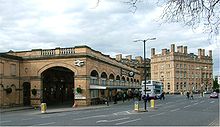 York railway station and Royal York Hotel
York railway station and Royal York Hotel
York has been a major railway centre since the first line arrived in 1839 at the beginning of the railway age. For many years the city hosted the headquarters and works of the North Eastern Railway.[35] York railway station is a principal stop on the East Coast Main Line from London to Newcastle and Edinburgh. It takes less than two hours to get to York from London by rail, with at least 25 direct trains each weekday. The station is also served by long distance trains on Cross Country services linking Edinburgh and Newcastle with destinations in south and west England via Birmingham.[86] TransPennine Express provide a frequent service of semi-fast trains linking York to Newcastle, Scarborough, Leeds, Manchester, Manchester Airport, and Liverpool. Local stopping services by Northern Rail connect York to Bridlington, Harrogate, Hull, Leeds, Sheffield and many intermediate points, as well as many other stations across Greater Manchester and Lancashire.[86]
York has an airfield at the former RAF Elvington, some 7 miles (11 km) south-east of the city centre, which is the home of the Yorkshire Air Museum. Elvington is used for private aviation. Plans have been drafted to expand the site for business aviation or a full commercial service.[87]
York is linked to Manchester Airport by an hourly direct TransPennine Express train, giving access to the principal airport serving the north of England, with connections to many destinations in Europe, North America, Africa, and Asia.[86] Leeds Bradford Airport is closer to York but the hourly York Air Coach service operated by First York was withdrawn as of April 2009.[88] Leeds Bradford Airport provides connections to most major European and North African airports as well as Pakistan and New York.
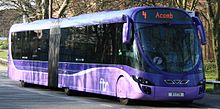 A York FTR bus
A York FTR bus
Public transport within the city is largely bus based. The principal bus operator is First York, a part of FirstGroup plc. First York operates the majority of the city's local bus services, as well as the York park and ride services. York is the location of the first implementation of FirstGroup's experimental, and controversial, ftr bus concept, which seeks to confer the advantages of a modern tramway system at a lower cost.[89] Transdev York and York Pullman also operate a number of local bus services. Open top tourist and sightseeing buses are operated by Transdev York on behalf of City Sightseeing, and by York Pullman.[90]
Rural services, linking local towns and villages with York, are provided by a number of companies.[91] Longer distance bus services are provided by a number of operators including, Arriva Yorkshire services to Selby, East Yorkshire Motor Services on routes to Hull, Beverley, Pocklington, Harrogate & District services to Knaresborough and Harrogate. Yorkshire Coastliner links Leeds via York with Scarborough, Filey, Bridlington and Whitby.[92]
Local Transport Plan 2006
English local authorities are required to produce Local Transport Plans (LTPs), strategies for developing local integrated transport as part of a longer-term vision. LTPs are used by central government to allocate funding for transport schemes.The final Local Transport Plan 2006–2011 for York was submitted to central government in March 2006. The plan addresses the fact that traffic in York is predicted to grow considerably over the coming years. The key aims of the plan are to ease congestion and improve accessibility, air quality and safety. Major funding allocations earmarked for the first five years of the plan's life span include outer ring road improvements, improved management of the highway network, improvements to the bus network including park and ride services, provision of off-road walking and cycling routes, air quality improvements and safety measures.[93]
Education
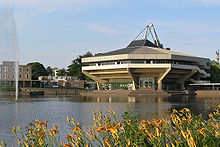 University of York, view across the lake to Central Hall
University of York, view across the lake to Central Hall See also: List of schools in York
See also: List of schools in YorkThe University of York's main campus is on the southern edge of the city at Heslington and is currently undergoing significant expansion with new buildings and departments including Law, Theatre, Film, and Television at Heslington East. The Department of Archaeology and the graduate Centres for Eighteenth Century Studies and Medieval Studies are located in the historic King's Manor in the city centre.[94] It was York's only institution with university status until 2006, when the more centrally located York St John University, formerly an autonomous college of the University of Leeds, attained full university status. The city also hosts a branch of The College of Law. The University of York also has a highly rated[95] medical school, Hull York Medical School.
The city has two major further education institutions. York College is an amalgamation of York Technical College and York Sixth Form College. Students there study a very wide range of academic and vocational courses, and range from school leavers and sixth formers to people training to make career moves.[96] Askham Bryan College offers further education courses, foundation and honours degrees, specialising in more vocational subjects such as horticulture, agriculture, animal management and even golf course management.[97]
There are 70 local authority schools with over 24,000 pupils in the City of York Council area.[98] The City of York Council manages most primary and secondary schools within the city. Primary schools cover education from ages 5–11, with some offering early years education from age 3. From 11–16 education is provided by 10 secondary schools, four of which offer additional education up to the age of 18.[99] In 2007 Oaklands Sports College and Lowfield Comprehensive School merged to become one school known as York High School.[100]
York also has several private schools. St Peter's School was founded in 627 and the scholar Alcuin, who went on to serve Charlemagne, taught here.[101] It was also the school attended by Guy Fawkes.[102] Two schools have Quaker origins: Bootham School is co-educational[103] and The Mount School is all-girls.[104] On the outskirts of the city is Queen Margaret's School. Pupils from The Minster School, York sing in York Minster choir.
Public services
Under the requirements of the Municipal Corporations Act 1835, York City Council had to appoint a Watch Committee which established a police force and appointed a chief constable.[105] On 1 June 1968 the York City, East Riding of Yorkshire and North Riding of Yorkshire police forces were amalgamated to form the York and North East Yorkshire Police. Since 1974, Home Office policing in York has been provided by the North Yorkshire Police. The force's "Central Area" has its headquarters for policing York and nearby Selby in Fulford, York.[106] Statutory emergency fire and rescue service is provided by the North Yorkshire Fire and Rescue Service, whose headquarters is at Northallerton.[107]
The first hospital in York, the York County Hospital, opened in 1740 in Monkgate[108] and was funded by public subscription. It closed in 1976 when it was replaced by the purpose built York Hospital, which opened in 1976 and gained Foundation status in April 2007. It has 524 adult inpatient beds and 127 special purpose beds providing general healthcare and some specialist inpatient, daycase and outpatient services.[109] It is also known as York District Hospital and YDH.[109]
The Yorkshire Ambulance Service NHS Trust was formed on 1 July 2006 bringing together South Yorkshire Ambulance Service, West Yorkshire Metropolitan Ambulance Service and the North and East Yorkshire parts of Tees, East and North Yorkshire Ambulance Service to provide patient transport.[110] Other forms of health care are provided for locally by several small clinics and surgeries.
The city's first subscription library opened in 1794,[111] but it wasn't until 1893 that York's first free public library was built to mark Queen Victoria's jubilee. The library was initially on Clifford Street, but a new building was built on Museum Street which opened in 1927, and which is still the library today.
Since 1998 waste management has been co-ordinated via the York and North Yorkshire Waste Partnership.[112] York's Distribution Network Operator for electricity is CE Electric UK;[113] there are no power stations in the city. Yorkshire Water, which has a local water extraction plant on the River Derwent at Elvington, manages York's drinking and waste water.[114] The city has its own Magistrates' Court,[115] and more unusually a Crown Court[116] and County Court too.[117] The Crown Court was designed by the architect John Carr, next to the then prison (including execution area).[118] The former prison is now the Castle Museum but still contains the cells.
Main sights
See also: York sites of interest and medieval churches of YorkYork Minster, the largest Gothic cathedral in northern Europe, stands at the city's centre.[119]
York Castle, a complex of buildings ranging from the medieval Clifford's Tower to the 20th century entrance to the York Castle Museum (formerly a prison) has had a chequered history.
York's centre is enclosed by the city's medieval walls, which are a popular walk.[120] The entire circuit is about 3 miles (5 km), including a part where walls never existed, because the Norman moat of York Castle, formed by damming the River Foss, also created a lake which acted as a city defence. This lake was later called the King's Fishpond, as the rights to fish belonged to the Crown.
A feature of central York is the Snickelways, narrow pedestrian routes, many of which led towards the former market-places in Pavement and St Sampson's Square.[121] The Shambles is a narrow medieval street, lined with shops, boutiques and tea rooms. Most of these premises were once butchers' shops, and the hooks from which carcasses were hung and the shelves on which meat was laid out can still be seen outside some of them. The street also contains the Shrine of Margaret Clitherow, although it is not located in the house where she lived.[122] Goodramgate has many medieval houses including the early 14th century Lady Row built to finance a Chantry, at the edge of the churchyard of Holy Trinity church.
As well as the Castle Museum, the city contains numerous other museums and historic buildings such as the Yorkshire Museum and its Museum Gardens, JORVIK Viking Centre, the York Art Gallery, the Richard III Museum, the Merchant Adventurers' Hall, the medieval house Barley Hall owned by the York Archaeological Trust, Fairfax House, owned by the York Civic Trust and the Treasurer's House owned by the National Trust.[123] The National Railway Museum is situated just beyond the station, and is home to a vast range of transport material and the largest collection of railway locomotives in the world. Included in this collection are the world's fastest steam locomotive LNER 4468 Mallard and the world famous 4472 Flying Scotsman, which is being overhauled in the Museum.[124]
York is noted for its numerous churches and pubs. Most of the remaining churches in York are from the medieval period. St William's College behind the Minster, and Bedern Hall, off Goodramgate, are former dwelling places of the canons of the Minster.[125]
Culture
Theatre
The Theatre Royal, which was established in 1744, produces an annual pantomime which attracts loyal audiences from around the country to see its veteran star, Berwick Kaler.[126] The Grand Opera House and Joseph Rowntree Theatre also offer a variety of productions.[127][128] The city is home to the Riding Lights Theatre Company, which as well as operating a busy national touring department, also operates a busy youth theatre and educational departments. York is also home to a number of amateur dramatic groups.[129] The Department of Theatre, Film and Television, and Student Societies of the University of York put on public drama performances.[130] The York Mystery Plays are performed every 4 years with texts based on the original medieval plays of this type that were performed by the guilds - often with specific connections to the subject matter of each play. (For instance the fishmongers used to present the play of Noah and the Flood.) The York Cycle of Mystery Plays or Pageants is the most complete in England. Originally performed from wagons at various locations around the city, following their resurrection in the middle of the 20th century as part of the quadrennial York City Festival, they were mostly produced in a temporary open-air theatre within the ruins of St. Mary's Abbey, using a mixture of professional and amateur actors. Lead actors have included Christopher Timothy (in the role of Christ) and Dame Judi Dench (who has appeared three times). Latterly the cycle has also been presented within York Minster and occasionally from wagons in the streets, recreating the original productions. The next cycle is due to take place in 2012 back in St. Mary's Abbey.[131]
Music
Among many music groups performing regularly in York are the Academy of St Olave's, a chamber orchestra which gives concerts in the beautiful setting of St Olave's Church, Marygate.[132] A former church, St Margaret's, Walmgate, is now the National Centre for Early Music, which hosts concerts, broadcasts, competitions and events through the year, especially during the York Early Music Festival.[133][134] Students, staff and visiting artists of York St John University music department regularly perform lunchtime concerts in the University chapel, alongside special performances such as the annual Christmas concert. The staff and students of the University of York also perform in the city and particularly in the Sir Jack Lyons Concert Hall on the Heslington campus.[135]
Gastronomy
 Bettys Café Tea Rooms
Bettys Café Tea Rooms
In September, York has an annual Festival of Food and Drink, which has been held in the city since 1997. The aim of the festival is to spotlight food culture in York and North Yorkshire by promoting local food production.The Festival generates up to 150,000 visitors over 10 days, from all over the country.[136] One of the notable local products is York ham, a type of cured ham,[137] which is a mild-flavoured ham that has delicate pink meat and does not need further cooking before eating. It is traditionally served with Madeira Sauce.[138][139] It is a lightly smoked, dry-cured ham, which is saltier but milder in flavour than other European dry-cured hams.[140] Folklore has it that the oak construction for York Minster provided the sawdust for smoking the ham. Robert Burrow Atkinson's butchery shop, in Blossom Street, is the birthplace of the original “York Ham” and the reason why the premises became famous.[141]
In the centre of York, in St Helen’s Square, there is the York branch of Bettys Café Tea Rooms. Bettys founder, Frederick Belmont, travelled on the maiden voyage of the Queen Mary in 1936. He was so impressed by the splendour of the ship that he employed the Queen Marys’ designers and craftsmen to turn a dilapidated furniture store in York into an elegant café in St Helen’s Square. A few years after Bettys opened in York war broke out, and the basement ‘Bettys Bar’, became a favourite haunt of the thousands of airmen stationed around York. ‘Bettys Mirror’, on which many of them engraved their signatures with a diamond pen, remains on display today as a tribute to them.[142]
Media
The York area is served by a local newspaper, The Press (known as the Evening Press until April 2006), The York Advertiser newspaper (based at The Press on Walmgate) and two local radio stations Minster FM and BBC Radio York.[143][144][145]
York St John University has a Film and Television Production department with links to many major industrial partners. The department hosts an annual festival of student work and a showcase of other regional films.[146]
The University of York has its own television station York Student Television (YSTV) and two campus newspapers Nouse and York Vision.[147] Its radio station URY is the longest running legal independent radio station in the UK, and was voted BBC Radio 1 Student Radio Station of the Year 2005.[148][149]
Sport
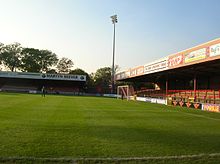 Bootham Crescent is the home ground of York City F.C.
Bootham Crescent is the home ground of York City F.C.
The city's football team is York City, currently playing in the Football Conference. York have played as high as the old Second Division but are best known for their "giant killing" status in cup competitions, having reached the FA Cup semi-final in 1955 and beaten Manchester United 3–0 during the 1995–96 League Cup. Their matches are played at Bootham Crescent.[150]
York also has a strong rugby league history. York FC, later known as York Wasps, formed in 1901, were one of the oldest rugby league clubs in the country but the effects of a move to the out of town Huntington Stadium, poor results and falling attendances led to their bankruptcy in 2002.[151] The supporters formed a new club, York City Knights, who now play at the same stadium in Championship 1.[152] There are three amateur rugby league teams in York, New Earswick All Blacks, York Acorn and Heworth. York International 9s is a rugby league nines tournament which takes place in York each year.[153] Amateur side York Lokomotive compete in the Rugby League Conference.
An open rowing club York City Rowing Club is located underneath Lendal Bridge.[154] The rowing clubs of The University of York, York St John University Rowing Club and Leeds University Boat Club as well as York City RC using the Ouse for training.
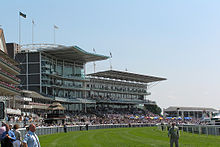 A view of the Stands at York Racecourse
A view of the Stands at York Racecourse
York Racecourse was established in 1731 and from 1990 has been awarded Northern Racecourse of the Year for 17 years running. This major horseracing venue is located on the Knavesmire and sees thousands flocking to the city every year for the 15 race meetings. The Knavesmire Racecourse also hosted Royal Ascot in 2005.[155] In August racing takes place over the three day Ebor Festival that includes the Ebor Handicap dating from 1843.[156]
Motorbike speedway once took place at York. The track in the Burnholme Estate was completed in 1930 and a demonstration event staged. In 1931 the track staged team and open events and the York team took part in the National Trophy.[157]
The most notable sportsmen to come from York in recent years are footballer Marco Gabbiadini and former England manager Steve McClaren,[158] who both attended Nunthorpe Grammar School (now called Millthorpe School).[159]
There are two sailing clubs close to York, both of which sail dinghies on the River Ouse. The York RI (Railway Institute) Sailing Club has a club bouse and boat park on the outskirts of Bishopthorpe, a village 3 miles (4.8 km) to the south of York. The Yorkshire Ouse Sailing Club has a club house in the village of Naburn, 5 miles (8.0 km) south of York.
Twin cities
York is twinned with:
There is also a community link with Fanteakwa District, Ghana.[161]
See also
- List of people associated with York
Notes
- a There was no census in 1941: figures are from National Register. United Kingdom and Isle of Man. Statistics of Population on 29 September 1939 by Sex, Age and Marital Condition.
- b There is a discrepancy of 37 between Office of National Statistics figures (quoted before) and those on the Vision of Britain website (quoted here).
References
- ^ Andalo, Debbie (26 March 2008). "Head to the capital of the north". London: The Guardian. http://www.guardian.co.uk/society/2008/mar/26/2. Retrieved 30 September 2008.
- ^ "The Chocolate City". York Press. 1999. http://archive.yorkpress.co.uk/1999/8/24/322649.html. Retrieved 30 September 2008.
- ^ "Resident Population Estimates by Ethnic Group (Percentages)". Office for National Statistics. 2005. http://www.neighbourhood.statistics.gov.uk/dissemination/LeadTableView.do?a=3&b=276825&c=York&d=13&e=13&g=392940&i=1001x1003x1004&m=0&r=1&s=1216832724475&enc=1&dsFamilyId=1812. Retrieved 26 July 2008.
- ^ a b "Timeline". Visit York. York Tourism Bureau. 2005. Archived from the original on 8 January 2008. http://web.archive.org/web/20080108205146/http://www.visityork.org/information/timeline.asp. Retrieved 25 October 2007.
- ^ a b "KS01 Usual resident population: Census 2001, Key Statistics for urban areas". Office for National Statistics. http://www.statistics.gov.uk/StatBase/ssdataset.asp?vlnk=8271&Pos=2&ColRank=1&Rank=224. Retrieved 17 June 2009.
- ^ "Mid Year Population Estimates for York". City of York Council. 4 March 2009. http://www.york.gov.uk/environment/Planning/Local_development_framework/LDF_Evidence_base/MYEforYork/. Retrieved 17 June 2009.
- ^ Hall, Richard (1996). English Heritage: Book of York (1st ed.). B.T.Batsford Ltd. p. 13. ISBN 0-7134-7720-2.
- ^ Schama, Simon (2003). A History of Britain: At the Edge of the World? - 3000 BC–AD 1603. 1. BBC Books. ISBN 0-563-48714-3.
- ^ Jones, Terry (2007). Barbarians. BBC Books. ISBN 978-0-563-53916-2.
- ^ Pryor, Francis (6 September 2004). Britain BC: Life in Britain and Ireland Before the Romans. HarperPerennial. ISBN 978-0-007-12693-4.
- ^ a b c "York's history". City of York Council. 20 December 2006. http://www.york.gov.uk/leisure/Local_history_and_heritage/yorks_history/. Retrieved 1 October 2007.
- ^ Willis, Ronald (1988). The illustrated portrait of York (4th ed.). Robert Hale Limited. p. 35. ISBN 0-7090-3468-7.
- ^ "Ebor Festival". York City of Festivals. http://www.yorkfestivals.com/metadot/index.pl?iid=2757&isa=Category. Retrieved 17 May 2009.
- ^ Debretts
- ^ Willis, Ronald (1988). The illustrated portrait of York (4th ed.). Robert Hale Limited. pp. 26–27. ISBN 0-709-03468-7.
- ^ a b Shannon, John; Tilbrook, Richard (1990). York - the second city. Jarrold Publishing. p. 2. ISBN 0-711-70507-0.
- ^ "Lower (Britannia Inferior) and Upper Britain (Britannia Superior)". Vanderbilt University. http://www.vanderbilt.edu/AnS/Classics/roman_provinces/britain/image21.htm. Retrieved 24 October 2007.
- ^ Russo, Daniel G. (1998), Town Origins and Development in Early England, c. 400–950 A.D., Greenwood Publishing Group, pp. 119–120, ISBN 9780313300790
- ^ Jones, Barri; Mattingly, David (1990), An Atlas of Roman Britain, Cambridge: Blackwell Publishers (published 2007), p. 317, ISBN 9781842170670. Cemeteries that are identifiably Anglian date from this period.
- ^ "York history timeline". YorkHistory.com. 2007. Archived from the original on 14 March 2007. http://web.archive.org/web/20070314135055/http://www.yorkhistory.com/timeline/index.php. Retrieved 4 October 2007.
- ^ "The First Minster: History of York". History of York. York Museums Trust. http://www.historyofyork.org.uk/themes/anglian-york/the-first-minster. Retrieved 18 July 2009.
- ^ a b c "York Minster: a very brief history". York Minster. http://www.yorkminster.org/learning/the-minsters-history/. Retrieved 15 June 2009.
- ^ Ritchie, Dr Anna (1 July 2001). "Alcuin of York". BBC History Online. BBC. http://www.bbc.co.uk/history/ancient/vikings/alcuin_01.shtml. Retrieved 18 July 2009.
- ^ "Jorvik: Viking York". City of York Council. 20 December 2006. http://www.york.gov.uk/leisure/Local_history_and_heritage/yorks_history/03_jorvik/. Retrieved 5 October 2007.
- ^ "York". 1911 Encyclopedia. http://www.1911encyclopedia.org/York. Retrieved 4 October 2007.
- ^ "Death in York". BBC. 28 September 2006. http://www.bbc.co.uk/religion/religions/judaism/history/pogromyork_1.shtml. Retrieved 10 October 2007.
- ^ "Norman and Medieval York". City of York Council. 20 December 2006. http://www.york.gov.uk/leisure/Local_history_and_heritage/yorks_history/04_norman/. Retrieved 1 October 2007.
- ^ a b P.M. Tillott, ed (1961). A History of the County of York: the City of York: The later middle ages - Communications, markets and merchants. British History Online. pp. 97–106. http://www.british-history.ac.uk/report.aspx?compid=36335&strquery=wool. Retrieved 18 July 2009.
- ^ a b "The Age of Decline". City of York Council. 20 December 2006. http://www.york.gov.uk/leisure/Local_history_and_heritage/yorks_history/05_the_age_of_decline/. Retrieved 5 October 2007.
- ^ a b c "Post-medieval York". Secrets Beneath Your Feet. York Archaeological Trust. 1998. http://www.yorkarchaeology.co.uk/secrets/pmedieval.htm. Retrieved 18 July 2009.
- ^ "Transplanted Englishman brings country's Guy Fawkes party tradition to Burnsville". ThisWeek Online (ThisWeek Newspapers). 24 October 2007. Archived from the original on 15 December 2005. http://web.archive.org/web/20051215081802/http://www.thisweek-online.com/2005/September/30bonfire.html.
- ^ "Georgian York - social capital of the North". City of York Council. 22 July 2008. http://www.york.gov.uk/leisure/Local_history_and_heritage/yorks_history/07_georgian/. Retrieved 5 October 2007.
- ^ "George Hudson". SchoolNet. Sparticus Educational. http://www.spartacus.schoolnet.co.uk/RAhudson.htm. Retrieved 12 June 2009.
- ^ "History of Nestlé Rowntree". Nestlé UK Ltd. 2008. Archived from the original on 4 January 2008. http://web.archive.org/web/20080104184252/http://www.nestle.co.uk/OurBrands/AboutOurBrands/ConfectioneryAndCakes/History+of+Rowntree.htm. Retrieved 19 July 2009.
- ^ a b c "The Railway Age to the present day". City of York Council. 20 December 2006. http://www.york.gov.uk/leisure/Local_history_and_heritage/yorks_history/08_the_railway_age/.
- ^ "Conservation Area 1" (PDF). York City Council. http://www.planningportal.gov.uk/uploads/yorkplan/Conservation%20Area%201.pdf. Retrieved 12 June 2009.[dead link]
- ^ "History of the NRM". National Railway Museum. http://www.nrm.org.uk/AboutUs/history.aspx. Retrieved 15 June 2009.
- ^ "Founding students return to York 40 years on". University of York. 7 October 2003. http://www.york.ac.uk/admin/presspr/pressreleases/alumnidinner.htm. Retrieved 15 June 2009.
- ^ "York voted top city for tourists". BBC News Online (BBC). 14 June 2007. http://news.bbc.co.uk/1/hi/england/north_yorkshire/6751753.stm. Retrieved 28 July 2008.
- ^ "Your MPs". City of York Council. http://democracy.york.gov.uk/mgMemberIndexMP.asp?bcr=1. Retrieved 19 July 2009.[dead link]
- ^ "Final recommendations for Parliamentary constituencies in the County of North Yorkshire and the City of York" (Microsoft Word document). Boundary Commission for England. 5 November 2003. http://www.boundarycommissionforengland.org.uk/review_areas/downloads/FR_NR_NYorks_York.doc. Retrieved 20 April 2010.[dead link]
- ^ "Your MEPs". City of York Council. http://democracy.york.gov.uk/mgMemberIndexMEP.aspx?bcr=1. Retrieved 6 March 2011.
- ^ Bartholomew, John (1887). "Gazetteer of the British Isles entry for York". A Vision of Britain Through Time. Great Britain Historical GIS Project. http://www.visionofbritain.org.uk/descriptions/entry_page.jsp?text_id=1960380&word=NULL. Retrieved 19 July 2009.
- ^ "Gazetteer of British Place Names - Map 2. Administrative counties and unitary authority areas". Association of British Counties. 10 September 2006. http://www.gazetteer.co.uk/gazmap2.htm. Retrieved 17 May 2009.
- ^ The North Yorkshire (District of York) (Structural and Boundary Changes) Order. Stationery Office Books. 6 April 1995. ISBN 978-0110526058. http://www.opsi.gov.uk/SI/si1995/Uksi_19950610_en_9.htm. Retrieved 17 May 2009.
- ^ "Your councillors". City of York Council. http://democracy.york.gov.uk/mgMemberIndex.asp?bcr=1. Retrieved 19 July 2009.
- ^ a b "The Constitution - Part 1 Summary and explanation" (PDF). City of York Council. http://democracy.york.gov.uk/Published/StdDataDocs/3/1/6/0/SD00000613/$part1.doc.pdf. Retrieved 19 July 2009.
- ^ "City of York local elections 2011". City of York Council. 6 May 2011. http://www.york.gov.uk/council/Elections_and_democracy/elections/Elections_results/2011-05-05/result. Retrieved 9 September 2011.
- ^ "committee details - leisure culture and social inclusion". York City Council. http://democracy.york.gov.uk/mgCommitteeDetails.aspx?ID=676. Retrieved 10 May 2010.
- ^ "committee details - city strategy". York City Council. http://democracy.york.gov.uk/mgCommitteeDetails.aspx?ID=672. Retrieved 10 May 2010.
- ^ "David Horton sworn in as new Lord Mayor of York". City of York Council. May 2011. http://www.york.gov.uk/news/latestNews/PR2068. Retrieved 26 May 2010.
- ^ "York Youth Council". York Youth Council. http://www.yorkyouthcouncil.co.uk/. Retrieved 16 October 2011.
- ^ "York youth council holds first meeting". York Press. 19 October 2010. http://www.yorkpress.co.uk/news/8460315.York_youth_council_holds_first_meeting/?ref=rss. Retrieved 24 October 2011.
- ^ Hall, Richard (1996). English Heritage: Book of York (1st ed.). B.T.Batsford Ltd. p. 25. ISBN 0-7134-7720-2.
- ^ Dennis, Ian A.; Macklin, Mark G.; Coulthard, Tom J.; Brewer, Paul A. (2002). "The impact of the October–November 2000 floods on contaminant metal dispersal in the River Swale catchment, North Yorkshire, UK" (PDF). Wiley InterScience. p. 1. Archived from the original on 29 November 2007. http://web.archive.org/web/20071129111926/http://www.aber.ac.uk/iges/staff/Macklin+files/HP+Dennis+et+al.+2003.pdf. Retrieved 23 September 2007.
- ^ "England Rural Development Programme: Appendix A3 – Yorkshire and The Humber Region - Section 1 Description Of Current Situation In The Yorkshire And The Humber Region" (PDF). East Yorkshire Coastal Observatory. pp. 2–3. http://www.hull.ac.uk/coastalobs/media/pdf/appendixa3.pdf. Retrieved 15 June 2009.
- ^ "Average Conditions:York, United Kingdom". BBC Weather. BBC. http://www.bbc.co.uk/weather/world/city_guides/results.shtml?tt=TT003820/. Retrieved 24 July 2008.
- ^ "Weather Pages". Department of Electronics, University of York. http://weather.elec.york.ac.uk/. Retrieved 27 May 2011.
- ^ "Average Conditions - York, United Kingdom". BBC Weather. BBC. http://www.bbc.co.uk/weather/world/city_guides/results.shtml?tt=TT003820. Retrieved 8 March 2010.
- ^ "People and Society: Population and Migration: Key Figures: Area: York (Local Authority)". Neighbourhood Statistics. Office for National Statistics. http://www.neighbourhood.statistics.gov.uk/dissemination/LeadKeyFigures.do?a=7&b=276825&c=York&d=13&e=13&g=392940&i=1001x1003x1004&m=0&r=1&s=1242742906281&enc=1. Retrieved 19 May 2009.
- ^ "2001 Census: Key Statistics: Household Composition (KS20): Area: York (Local Authority)". Neighbourhood Statistics. Office for National Statistics. http://www.neighbourhood.statistics.gov.uk/dissemination/LeadTableView.do?a=7&b=276825&c=York&d=13&e=15&g=392940&i=1001x1003x1004&m=0&r=1&s=1242741872656&enc=1&dsFamilyId=55. Retrieved 19 May 2009.
- ^ a b c "Crime figures for 2007/08 in York". UpMyStreet. http://www.upmystreet.com/local/crime-in-york.html. Retrieved 19 May 2009.
- ^ "York UA/City: Total Population". A Vision of Britain Through Time. Great Britain Historical GIS Project. http://www.visionofbritain.org.uk/data_cube_page.jsp?data_theme=T_POP&data_cube=N_TOT_POP&u_id=10057127&c_id=10001043&add=N. Retrieved 19 July 2009.
- ^ a b "2001 Census: Census Area Statistics: Key Figures: Area: York (Local Authority)". Neighbourhood Statistics. Office for National Statistics. http://www.neighbourhood.statistics.gov.uk/dissemination/LeadKeyFigures.do?a=3&b=276825&c=york&d=13&e=16&g=392940&i=1001x1003x1004&m=0&enc=1&bhcp=1. Retrieved 11 July 2007.
- ^ "Welcome to the Diocese of York". The Diocese of York. 2007. Archived from the original on 16 July 2008. http://web.archive.org/web/20080716053939/http://www.dioceseofyork.org.uk/index.shtml. Retrieved 19 July 2009.
- ^ "Parishes". Middlesbrough Diocese. 2007. http://middlesbrough-diocese.org.uk/?page_id=64. Retrieved 19 July 2009.
- ^ "Quakers in the York area". yorkquakers.org.uk. http://www.yorkquakers.org.uk/. Retrieved 19 July 2009.
- ^ "Circuits & Churches". The Methodist Church York and Hull District. http://www.yorkhullmethodist.org.uk/index.php?cid=29&pid=20. Retrieved 6 March 2011.
- ^ "York Mosque and Islamic Centre - About Us". York Mosque. http://yorkmosque.org/index.php?option=com_content&task=view&id=5&Itemid=6. Retrieved 15 June 2009.
- ^ "Buddhist organisations in York, NY, North-East areas". CommuniGate. This is Bradford. http://www.communigate.co.uk/brad/leedsbuddhistgroup/page5.phtml. Retrieved 19 July 2009.
- ^ a b "Labour Market ProfileYork". Nomis. Office for National Statistics. https://www.nomisweb.co.uk/reports/lmp/la/2038432023/report.aspx. Retrieved 17 July 2009.
- ^ Top 20 Most visited English Cities and Towns in 2009 by UK Residents, http://www.enjoyengland.com/Images/top%20towns%202009_tcm21-190501.pdf, retrieved 7 September 2010
- ^ Top 20 Most Popular UK Cities for International Visitors, http://gouk.about.com/od/getawaysandshorthops/qt/top20.htm, retrieved 7 September 2010
- ^ "The Major Employers in the City of York Council area." (PDF). City of York Council. 2008. http://www.york.gov.uk/content/45053/31645/Economic_intelligence/major_companies.pdf. Retrieved 1 June 2009.
- ^ "University of York Profile 2009." (PDF). University of York. 2009. http://www.york.ac.uk/media/communications/corporatepublications/Profile%202009%20reduced%203.pdf. Retrieved 3 August 2009.
- ^ a b "The Future York Group Report: An Independent Strategic Review of the York Economy" (PDF). The Future York Group Report. June 2007. http://www.york.gov.uk/content/45053/31645/Economic_intelligence/FYG_Main_Report.pdf. Retrieved 22 January 2008.
- ^ "Yet more railway jobs axed in York". The Press. Newsquest Media Group. 13 September 2006. http://www.thepress.co.uk/news/917865.yet_more_railway_jobs_axed_in_york/. Retrieved 19 July 2009.
- ^ "More jobs lost at chocolate firm". BBC News Online (BBC). 20 September 2006. http://news.bbc.co.uk/1/hi/england/north_yorkshire/5363992.stm. Retrieved 19 July 2009.
- ^ "Job losses 'bitter blow' for city". BBC News Online (BBC). 14 September 2006. http://news.bbc.co.uk/1/hi/england/north_yorkshire/5345168.stm. Retrieved 19 July 2009.
- ^ "York reels from Norwich Union job cuts shock". York Press. Newsquest Media Group. 3 April 2009. http://www.thepress.co.uk/search/4263943.York_reels_from_Norwich_Union_job_cuts_shock/. Retrieved 8 April 2009.
- ^ "Welcome to Science City York - 10 Years Promoting Innovation and Creativity". Science City York. http://www.sciencecityyork.org.uk/. Retrieved 15 June 2009.
- ^ "About Science City York". Science City York. 2006. Archived from the original on 4 August 2007. http://web.archive.org/web/20070804055318/http://www.sciencecityyork.org.uk/about/index.html. Retrieved 19 January 2008.
- ^ "Regional Gross Value Added" (PDF). Office of National Statistics. 2005. pp. 240–253. http://www.statistics.gov.uk/downloads/theme_economy/RegionalGVA.pdf. Retrieved 19 July 2009.
- ^ a b "History of the River Ouse (Yorkshire)". waterscape.com. British Waterways. http://www.waterscape.com/canals-and-rivers/river-ouse-yorkshire/history. Retrieved 10 October 2007.
- ^ "Park & Ride". City of York Council. 31 August 2007. http://www.york.gov.uk/transport/Parking/Park_and_Ride/. Retrieved 9 October 2007.
- ^ a b c "Trains". City of York Council. 31 August 2007. http://www.york.gov.uk/transport/Public_transport/trains/. Retrieved 9 October 2007.
- ^ "Up in the air for Elvington". Evening Press. Newsquest Media Group. 9 October 2003. http://archive.thisisyork.co.uk/2003/10/9/258266.html. Retrieved 20 July 2009.
- ^ "Welcome to YorkAirLink.com". First Group plc. http://www.yorkaircoach.com. Retrieved 20 September 2009.
- ^ "ftr - York's new public transport scheme". City of York Council. 22 May 2008. http://www.york.gov.uk/transport/Public_transport/ftr/. Retrieved 20 July 2009.
- ^ Millar, Alan (June 2007). "K&J revives York Pullman identity to expand its local market". Buses (Ian Allan Publishing) (672): 8.
- ^ "Bus companies operating in York". City of York Council. 9 June 2009. http://www.york.gov.uk/transport/Public_transport/buses/Bus_Operators/. Retrieved 20 July 2009.
- ^ "History of the Yorkshire Coastliner - Linking Leeds and York with the Coast". Yorkshire Coastliner. http://www.yorkshirecoastliner.co.uk/about/history.asp. Retrieved 17 May 2009.
- ^ "Local Transport Plan 2006–2011". City of York Council. 23 February 2007. http://www.york.gov.uk/transport/Local_transport_plan/LocalTransportPlan/. Retrieved 18 May 2009.
- ^ "The University of York". University of York. http://www.york.ac.uk/. Retrieved 19 May 2009.
- ^ "Guardian Medical school ranking tables". Guardian Education (London: Guardian News and Media Limited). 2009. http://education.guardian.co.uk/universityguide2005/table/0,15905,-5163909,00.html. Retrieved 17 July 2009.
- ^ "About the new college". York College. http://www.yorkcollege.ac.uk/new-college/news/index.html. Retrieved 19 May 2009.[dead link]
- ^ "Welcome to Askham Bryan College". Askham Bryan College. http://www.askham-bryan.ac.uk/. Retrieved 19 May 2009.
- ^ "Schools and colleges". City of York Council. 4 February 2009. http://www.york.gov.uk/education/Schools_and_colleges/. Retrieved 17 June 2009.
- ^ "Secondary schools in York". City of York Council. 1 February 2007. http://www.york.gov.uk/education/Schools_and_colleges/Secondary_schools_directory/. Retrieved 17 June 2009.
- ^ "£10m merger unveiled as ‘York High School’". The Press. Newsquest Media Group. 28 September 2006. http://www.thepress.co.uk/news/942080.10m_merger_unveiled_as_york_high_school/. Retrieved 19 May 2009.
- ^ "Catholic Encyclopedia: Alcuin". New Advent. http://www.newadvent.org/cathen/01276a.htm. Retrieved 1 May 2009.
- ^ "Guy Fawkes History". St Peter's School Archives. Archived from the original on 19 April 2008. http://web.archive.org/web/20080419054604/http://www.st-peters.york.sch.uk/history/guyfawkes.htm. Retrieved 1 May 2009.
- ^ "The School and its Ethos". Bootham School York. http://www.boothamschool.com/school_ethos.html. Retrieved 19 May 2009.
- ^ "Welcome to The Mount School York". The Mount School York. http://www.mountschoolyork.co.uk/mount-parents.php. Retrieved 19 May 2009.
- ^ P.M. Tillott, ed (1961). A History of the County of York: the City of York: Public services. British History Online. pp. 460–472. http://www.british-history.ac.uk/report.aspx?compid=36381#s8. Retrieved 20 September 2009.
- ^ "North Yorkshire Police : Central Area Commander - Chief Superintendent Ali Higgins". North Yorkshire Police. http://www.northyorkshire.police.uk/index.aspx?articleid=1051. Retrieved 20 July 2009.[dead link]
- ^ "Welcome to the website of North Yorkshire Fire & Rescue Service". North Yorkshire fire and Rescue Service. http://www.northyorksfire.gov.uk/index.html. Retrieved 18 May 2009.
- ^ "York County Hospital". York History. http://www.yorkhistory.org.uk/hospital.html. Retrieved 10 August 2010.
- ^ a b "York Hospital - About our hospital". National Health Service. http://www.nhs.uk/servicedirectories/pages/hospital.aspx?id=rcb55. Retrieved 18 May 2009.
- ^ "About Us - Yorkshire Ambulance Service NHS Trust". Yorkshire Ambulance Service. http://www.yas.nhs.uk/AboutUs/aboutus.html. Retrieved 18 May 2009.
- ^ "York History - York Public Library". York History. http://www.yorkhistory.org.uk/library.html. Retrieved 24 January 2011.
- ^ "History". The York and North Yorkshire Waste Partnership. http://www.letstalklessrubbish.com/ltlr/Main.nsf/LookupUnid/D2703AD852D1C83E802572E30053BEE9?opendocument. Retrieved 18 May 2009.
- ^ "Welcome - CE Electric UK". CE Electric UK. http://www.ceelectricuk.co.uk/page/index.cfm. Retrieved 18 May 2009.
- ^ "Your water services". Yorkshire Water. http://www.yorkshirewater.com/your-water-services.aspx. Retrieved 18 May 2009.
- ^ "Her Majesty's Courts Service - York Magistrates' Court". Her Majesty's Courts Service. http://www.hmcourts-service.gov.uk/HMCSCourtFinder/SearchLinked.do?court_name=York%20Magistrates%27%20Court. Retrieved 17 May 2009.
- ^ "Crown Court Directory - York". CourtServe Legal Information Centre. http://www.courtserve.net/directories/crown-court/york.htm. Retrieved 17 June 2009.[dead link]
- ^ "County Court Directory - York". CourtServe Legal Information Centre. http://www.courtserve.net/directories/county-court/york.htm. Retrieved 17 June 2009.[dead link]
- ^ "John Carr - Architect: History of York". York Museums Trust. http://www.historyofyork.org.uk/timeline/georgian/john-carr-architect. Retrieved 17 May 2009.
- ^ "York Minster, York, UK". BBC. 19 March 2007. http://www.bbc.co.uk/dna/h2g2/A20361881. Retrieved 12 June 2009.
- ^ "The city walls". York City Council. 20 March 2009. http://www.york.gov.uk/visiting/The_city_walls/. Retrieved 12 June 2009.
- ^ Jones, Mark W; Et al (31 January 2004). A Walk Around the Snickelways of York. Dales Court Press. ISBN 9781871125726.
- ^ "The Shambles, York UK". Inside York. http://www.insideyork.co.uk/shambles. Retrieved 12 June 2009.
- ^ "York - Museums & Art Galleries". Tourist Net UK Ltd. http://www.touristnetuk.com/Ne/york/attractions/museums.htm. Retrieved 12 June 2009.
- ^ "About Flying Scotsman". National Railway Museum. http://www.flyingscotsman.org.uk/about.aspx. Retrieved 3 September 2007.
- ^ Sheahan, James Joseph; Whellan, T. (1857). History and Topography of the City of York, the East Riding of Yorkshire and a Portion of the West Riding. 1. Google Books. p. 501. http://books.google.com/books?id=t5gaAAAAYAAJ&pg=PA503&lpg=PA503&dq=%22ralph+de+paganel%22&source=bl&ots=X3Br0xvR_d&sig=7SUmWMZLbKX1s5b8EJPSKWpIgxU&hl=en&ei=vFcoSq-FM464lAeP5_WtAw&sa=X&oi=book_result&ct=result&resnum=8#PPA501,M1. Retrieved 12 June 2009.
- ^ Hickling, Alfred (15 December 2008). "Theatre review: Dick Turpin - Theatre Royal, York". guardian.co.uk (London: Guardian News and Media Limited). http://www.guardian.co.uk/stage/2008/dec/15/theatre-review-dick-turpin-pantomime. Retrieved 18 May 2009.
- ^ "What's on Grand Opera House York". Grand Opera House York. http://www.grandoperahouseyork.org.uk/whatson.asp?venueid=94. Retrieved 15 June 2009.
- ^ "About Joseph Rowntree Theatre". Joseph Rowntree Theatre Limited. http://jrtheatre.co.uk/about/. Retrieved 15 June 2009.
- ^ "About Riding Lights". Riding Lights Theatre Company. http://www.ridinglights.org/aboutus/. Retrieved 15 June 2009.
- ^ "Department of Theatre, Film and Television - The University of York". Department of Theatre, Film and Television, University of York. http://www.york.ac.uk/depts/tft/. Retrieved 15 June 2009.
- ^ "York Mystery Plays 2012". http://www.yorkmysteryplays-2012.com/. Retrieved 19 October 2011.
- ^ "Academy of St. Olave's Orchestra - Welcome". Academy of St Olave's. 2008. http://www.academyofstolaves.org.uk/. Retrieved 17 June 2009.
- ^ "The National Centre for Early Music, York: Welcome". The National Centre for Early Music. http://www.ncem.co.uk/. Retrieved 17 June 2009.
- ^ "York Early Music Festival: Overview". The National Centre for Early Music. http://www.ncem.co.uk/yemf.shtml. Retrieved 17 June 2009.
- ^ "University of York Concerts". University of York. http://music.york.ac.uk/concerts/newconcerts/. Retrieved 17 June 2009.
- ^ "York Festival of Food and Drink - Who we are and what we do:". York Food Festival Ltd. http://www.yorkfoodfestival.com/AboutUs.htm. Retrieved 15 June 2009.
- ^ "Food Legends of the United Kingdom: York Ham". Information Britain. http://www.information-britain.co.uk/food/foodlegends/York%20Ham/. Retrieved 11 November 2009.
- ^ "Home Cooking - Ham Varieties and Terminology". About.com. The New York Times Company. 16 September 2008. http://homecooking.about.com/library/weekly/blham.htm. Retrieved 5 October 2008.
- ^ "Recipe Favourites York ham and other recipes related to York ham". Recipe Tips. http://www.recipetips.com/search.asp?index=recipes&querytext=york+ham. Retrieved 5 October 2008.
- ^ Alden, Lori. "Cook's Thesaurus: Ham". Food Subs. http://www.foodsubs.com/MeatcureHams.html. Retrieved 5 October 2008.
- ^ "History of 57 & 59 Blossom Street". Oliver's Of The Mount. http://www.oliversofthemount.com/history.html. Retrieved 5 October 2008.
- ^ "Bettys Café Tea Rooms, York". Bettys & Taylors of Harrogate Limited. http://www.bettys.co.uk/cafe.asp?storyid={EBCDFAEA-C6F5-4F2A-AB0E-7C07A94D5241}. Retrieved 14 June 2009.
- ^ "York news, North Yorkshire news and information from The Press newspaper in York". The Press. Newsquest Media Group. http://www.thepress.co.uk/news/. Retrieved 12 June 2009.
- ^ "Minster FM - Welcome". Minster FM. The Local Radio Company. http://www.minsterfm.com/mi/welcome/. Retrieved 12 June 2009.[dead link]
- ^ "BBC Radio York". BBC Local - York & North Yorkshire. BBC. http://www.bbc.co.uk/northyorkshire/local_radio/. Retrieved 12 June 2009.
- ^ "Film & Television Production BA (Hons) Entry Profile". York St John University. 2006. http://www2.yorksj.ac.uk/default.asp?Page_ID=4724. Retrieved 12 June 2009.
- ^ "YSTV - Watch TV. Make TV. YSTV". York Student Television. http://ystv.york.ac.uk/. Retrieved 12 June 2009.
- ^ "University Radio York - About URY". University Radio York. Archived from the original on 2 June 2008. http://web.archive.org/web/20080602223445/http://ury.york.ac.uk/about.php. Retrieved 21 July 2009.
- ^ "URY - Media UK". Media UK. Archived from the original on 16 June 2008. http://web.archive.org/web/20080616185026/http://www.mediauk.com/the_knowledge/i.muk/URY. Retrieved 21 July 2009.
- ^ "York City FC Official Website". York City FC. http://www.ycfc.net/. Retrieved 12 June 2009.
- ^ "York lose survival fight". BBC Sport (BBC). 20 March 2002. http://news.bbc.co.uk/sport1/hi/rugby_league/1882617.stm. Retrieved 15 June 2009.
- ^ "Welcome to the Official York City Knights website". York City Knights. http://www.yorkcityknights.co.uk/index2.html. Retrieved 12 June 2009.
- ^ "York International Rugby 9s". York City of Festivals. 2005. http://www.yorkfestivals.com/metadot/index.pl?iid=3982. Retrieved 20 July 2009.
- ^ "York City Rowing Club". York City Rowing Club. http://www.ycrc.co.uk/. Retrieved 12 June 2009.
- ^ "Day One: Royal Ascot at York". BBC Sport (BBC). 14 June 2005. http://news.bbc.co.uk/sport1/hi/other_sports/horse_racing/4088800.stm. Retrieved 19 July 2009.
- ^ "York Racecourse History". York Racecourse. http://www.yorkracecourse.co.uk/about-york-racecourse/history. Retrieved 12 June 2009.
- ^ "York Speedway". John Skinner. http://www.defunctspeedway.co.uk/York%20Speedway.htm. Retrieved 19 July 2009.
- ^ "Millthorpe School - Steve McClaren - Nunthorpe Grammar School". Millthorpe School. http://www.millthorpeschool.co.uk/school/expupils/nunthorpe.php. Retrieved 19 July 2009.[dead link]
- ^ "Saturday Spotlight: McClaren makes his mark on Marco". The Northern Echo. Newsquest Media Group. 6 May 2006. http://archive.thenorthernecho.co.uk/2006/5/6/224457.html. Retrieved 19 July 2009.
- ^ a b "Town twinning - City of York Council". City of York Council. 20 April 2009. http://www.york.gov.uk/visiting/Town_twinning/. Retrieved 19 May 2009.
- ^ York Fanteakwa Community Link YOWLA Online
External links
- Photos and images
- Imagine York: Historic Photographs Online Council Library Archive of historic photographs of York, searchable by keyword.
- The Evelyn collection of pictures of York from the early 20th century
- Virtual Tour of York Panoramic views from 2000 to the present day.
- Pictures from York.
- Historical and genealogical sources
- The City of York: historical and genealogical information at GENUKI
- History of York Comprehensive site dedicated to the history of the city.
- Life in a Mediæval City Illustrated by York in the XVth Century
Members of the Hanseatic League by Quarter Chief cities are highlighted; Free Imperial Cities of the Holy Roman Empire are shown in italics. Wendish Quarter Anklam · Demmin · Greifswald · Hamburg · Kolberg (Kołobrzeg) · Lüneburg · Rostock · Rügenwalde (Darłowo) · Stettin (Szczecin) · Stolp (Słupsk) · Stockholm · Stralsund · Visby · Wismar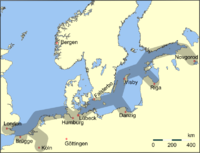
Saxon Quarter Baltic Quarter Westphalian
QuarterPrincipal Kontore Subsidiary Kontore Other cities * Cologne and Dortmund were both capital of the Westphalian Quarter at different times.
† Antwerp gained importance once Bruges became inaccessible due to the silting of the Zwin channel. Districts of Yorkshire and the Humber
Districts of Yorkshire and the HumberLincolnshire 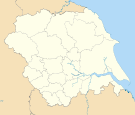
North Yorkshire Craven • Hambleton • Harrogate • Richmondshire • Ryedale • Scarborough • Selby • York
South Yorkshire West Yorkshire Ceremonial county of North Yorkshire Yorkshire Portal Unitary authorities Boroughs or districts Major settlements Bedale • Bentham • Boroughbridge • Catterick Garrison • Easingwold • Eston • Filey • Grassington • Guisborough • Harrogate • Hawes • Haxby • Helmsley • Ingleby Barwick • Kirkbymoorside • Knaresborough • Leyburn • Loftus • Malton • Masham • Middleham • Middlesbrough • Northallerton • Norton-on-Derwent • Pateley Bridge • Pickering • Redcar • Richmond • Ripon • Saltburn • Scarborough • Selby • Settle • Sherburn-in-Elmet • Skelton-in-Cleveland • Skipton • South Bank • Stokesley • Tadcaster • Thirsk • Thornaby-on-Tees • Whitby • Yarm • York
See also: List of civil parishes in North YorkshireRivers Topics Parliamentary constituencies • Grade I listed buildings • Monastic houses • Museums • WindmillsCities of the United Kingdom England Bath · Birmingham · Bradford · Brighton and Hove · Bristol · Cambridge · Canterbury · Carlisle · Chester · Chichester · Coventry · Derby · Durham · Ely · Exeter · Gloucester · Hereford · Kingston upon Hull · Lancaster · Leeds · Leicester · Lichfield · Lincoln · Liverpool · London · Manchester · Newcastle upon Tyne · Norwich · Nottingham · Oxford · Peterborough · Plymouth · Portsmouth · Preston · Ripon · St Albans · Salford · Salisbury · Sheffield · Southampton · Stoke-on-Trent · Sunderland · Truro · Wakefield · Wells · Westminster · Winchester · Wolverhampton · Worcester · York
Scotland Wales Northern Ireland Categories:- York
- 71 establishments
- Populated places established in the 1st century
- County towns in England
- Leeds City Region
- Local government districts of North Yorkshire
- Unitary authorities of England
- Trading posts of the Hanseatic League
- University towns in the United Kingdom
- Roman colonies
- Cities in Yorkshire and the Humber
- Local government districts of Yorkshire and the Humber
- Walled towns
Wikimedia Foundation. 2010.

